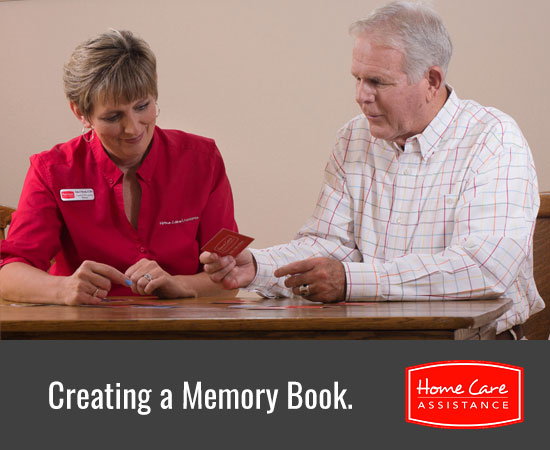A person’s sense of self stems from where they have come from, their accomplishments, and the people in their lives. Unfortunately, dementia can steal these memories and experiences from people, which affects what they believe, who they trust, how they view the world and their own self-esteem.
Maintaining Sense of Self
One great way to help those living with dementia to maintain a sense of who they are and capture their life experiences is to create a “Memory Book.” Using a memory book or scrapbook can be an effective way to help maintain these memories and experiences, as well as promote an avenue of communication for the caregiver or loved one supporting them. Memory books are a non-threatening way to help spark conversation about cherished memories that may have been forgotten.
Making Memory Books
Making a memory book can be a shared experience by having your loved one with dementia help you sort through old family photographs. As they talk about who or what is in the picture, write down the information and place it next to the photograph in the book. This process allows your loved one to participate in the process and take ownership of it, which can a rewarding experience.
If the person with dementia does not have the ability to recall information about the photos or memorabilia you can create another type of memory book by finding images on the internet. You can search for images of items that were popular when they were younger, such as:
Some “behaviors” that may arise and are not limited to:
- Clothing, swimsuits, and shoes
- Movie stars and favorite movie posters
- Books, or toys that they enjoyed
- Automobiles
- Resistance to bathing, dressing, or eating
- Work environments and recreational activities
Print these images off and place them in sleeve protectors in a 3-ring binder. Discuss what it was like when they were younger, asking them to “tell me about…” the picture in front of them. Reviewing these types of photos often brings about smile and fond memories.
Examples of Memory Book pages. Click image to enlarge.
What to include in Memory Books
Photos are not the only items that can go into a memory book. You can put in news clippings, awards and recognitions, items related to their families, careers, hobbies, trips, and desires. One strategy in making a memory book is to put photos and/or items in chronological order or you can place items in groups according to the subject.
Use their environment around them to gather more information on items to include in their memory book. What kinds of things are important to them? Do they have a collection of any kind? Do they have art on the walls? Do they have pets? Books? Movies? The options are endless, and the goal is to include items that reflect who they are and what is important to them.
Connecting with Memory Books
When making a memory book, it is important to not rush through the process. Taking a stroll down memory lane can be a very gratifying experience. It can also produce feelings of sadness or despair. If this happens, allow them to share their feelings and acknowledge them, without trying to “shut them down.” Helping your loved one identify and express their feelings promotes positive communication and trust amongst each other.
Being able to sit down with your loved one with dementia and talking about the “good ‘ol days” can be a powerful and rewarding experience, as well as give opportunities for positive communication and interactions for both of you.
For additional articles and videos on managing dementia, visit the blog and video sections of our website. You can also register to attend a Family Dementia Training session here.











